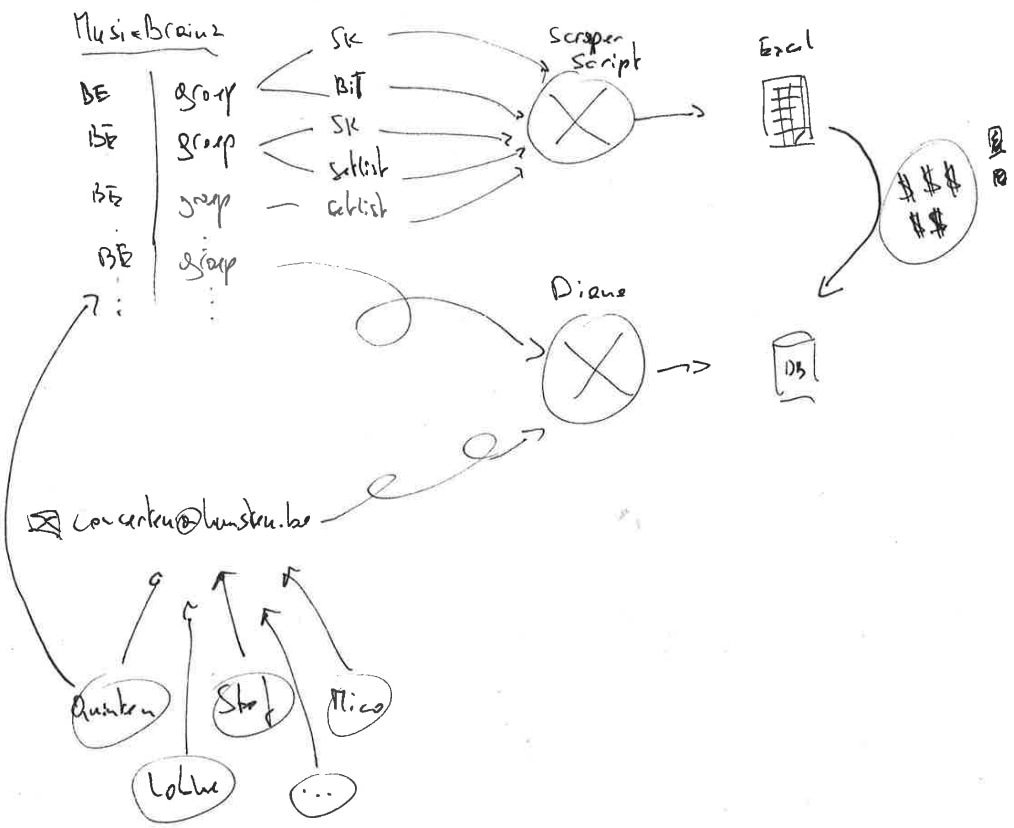
Grabbing the data: concerts abroad
Flanders Arts Institute is releasing slowly its first attempts in a trajectory on the international success of Flemish music. Be sure to read up on tales from the road, and a first look on some data.
Perhaps you are interested to know where we get the data for these studies? A broad overview of how Kunstenpunt collects data was already presented earlier; here we zoom in on the methodology behind getting data about concerts abroad.
Two channels, multiple sources
For now, we get data from two channels. The first channel is simply “other people”. In Flanders Arts Institute, we have many well-informed people that pass on invitations and announcements of concerts. The idea is also that people outside our organisation can submit concert announcements to concerts@kunsten.be, but for now, we are not actively promoting this. This channel, to which about 4 sources now contribute, delivers mostly concerts from internationally active classical ensembles, and underground non-classical music.
The second channel is a bit more technologically sexy, because we connect with the APIs of existing concert aggregation websites, bringing us sources such as Bands in Town, Songkick, and Setlist.fm. This channel delivers concerts from mainstream and alternative mainstream bands that have discovered these sources to reach a wider (international) audience. We keep track of these sources by using MusicBrainz.

We hope that both channels are somewhat complementary, but this is still under investigation.
How do you select and manage bands to track?
For both channels, it is necessary to have a list of bands/ensembles/musicians that you can track. Moreover, we need to know which bands are active on the Songkick, Bands in Town and Setlist.fm platforms (and which not, because these we have to track “manually”). Also, it is pointless to go and search through the thousands and thousands of concerts that are posted and announced every day to see if there is a Belgian band somewher. Rather, a “top-down” tracking of a closed set of bands is a more tractable and feasible approach. So, how do we select these bands?
Rather than going into the difficult discussion of “what is a Belgian band” , let’s be pragmatic here. Clearly, we have our enormous music releases database (muziekcentrum.be) to give us an idea of the bands that are making and releasing music in Flanders. Next to that, we can also look at Musicbrainz, which already contained a long list of artists and bands that are marked to be active in an area in Belgium. This, in combination with the extensive field knowledge of the music experts in Kunstenpunt, provides us with a long list of several thousand bands that are potentially playing abroad.

The nice thing, however, is that we decided to manage this list on musicbrainz.org. As such, Kunstenpunt/Flanders Arts Institute is actively strengthening the position of Belgian artists on the internet, as musicbrainz is internationally used as a metadata store, e.g. by the BBC and numerous music players. You can see the efforts of the people in Flanders Arts Institute to contribute to MusicBrainz by following these two profiles: Q and D.
Why Songkick and Bands In Town?
It turns out that these two platforms are actively used by many musicians and bands in Flanders. The reason for this is probably to be found in the fact that they offer very easy integration with Facebook, which is an ideal tool to reach out the audience.
On the surface, Songkick offers “clearner” data than Bands In Town, mainly because Songkick controls the venues for the concerts better, i.e. there is some control on orthographic variants of venue names, city names, and country names. Bands In Town, on the contrary, does not do this. Also, it seems as if somewhat more Belgian/Flemish bands are active on Songkick, rather than on Bands In Town, but the differences are not so large. Moreover, as soon as a band is on Bands In Town and on Songkick, there are only small, yet noticeable differences in the list of concerts.
What is so different about setlist.fm?
In contrast to Songkick and Bands In Town, which are fed mainly by the artists themselves, setlist.fm is a typical “crowdsourced” platform (like MusicBrainz). This means that there are a number of very motivated people that in their free time (or perhaps some semi-professionally) ingest a lot of manual data in excruciating detail. They do this out of love for data, music and structure, in contrast with the business model that is behind Songkick and Bands In Town.
So, what can you do with this data?
Ah, the eternal question: so now you have all this data, what can you do with it. What is it worth? Let me first explain the weaknesses.
The list of concerts is in most cases not complete
Especially for the historical data, we can not assume that all concerts are listed. However, given the integration with Facebook, we notice that bands have an increased incentive to put their concerts on these platforms, because Facebook is an excellent tool to reach out to the audience. So, for recent years, and for bands that have adopted a digital approach to connect with their audience, it could be that Songkick and Bands In Town offer a decent overview.
We are definitely forgetting some bands
The music scene consists of an osmosic layer that is difficult to grasp. I suppose that there is every week a band that comes into existence and one that perishes. Can we keep track? No, for sure not.
Is it legal?
Well, consuming the APIs of service providers comes with complying with Terms of Services. You can not just reuse the data from the commercial platforms. Moreover, sometimes APIs do not allow you to even store the data that you pull out of the API. We can always open up the umbrella of “research”, so I suppose we are safe.
But there are also some strengths and possibilities!
Conversation opener
Unlike a popular belief that data will give you new insights and magical innovation, very often, the data just confirms hypotheses and “things we already know”. But showing/confirming hypotheses allows you to continue the tought process, because you can stop discussing about the things everybody already knows (but slightly disagrees about).
Completing the picture
The data might be a way to actually complete the picture, but it is more likely that working with the data shows where the picture still needs to be completed. I think that this is the beauty of these data exercises: in a dialectic trajectory between qualitative and quantitative approaches, you reach a better understanding.
Strengthening the arguments
If the data does not entirely corroborate the gut feelings (and it is usually the case), it requires that the holder of the gut feeling argues “why” the data is not in line with the hypothesis. The simple act of having to make these arguments, will strengthen the existing arguments.
Maybe it does bring something new?
And let’s try not to be too cynical, maybe the data does bring a new insight or an eye opener!?
You want to find more about the data that we collect and investigate at Kunstenpunt? Do not hesitate to contact me at tom(at)kunsten.be or follow me on twitter.






